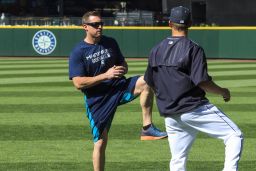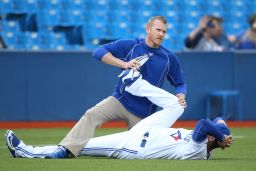Editor’s Note: Dana Santas is the creator of Radius Yoga Conditioning, a yoga style designed to help people move, breathe and feel better. She’s the yoga trainer for the Atlanta Braves, Philadelphia Phillies, Toronto Blue Jays, Tampa Bay Rays, Tampa Bay Lightning, and dozens of pros in the National Football League, National Hockey League, National Basketball Association, Major League Baseball and Professional Golfers’ Association.
Story highlights
MLB strength and conditioning coaches provide fitness advice that could apply to all of us
Coach: "Let's start with the first thing first, and take it one day at a time"
Warmer weather and more daylight mean increased opportunities for outdoor activities, like golfing, biking and swimming, that require greater fitness levels than most sedentary winter pastimes. Spring often serves as a wake-up call to get in shape quickly, so we can enjoy the time outside with confidence and comfort.
Major League Baseball players report to spring training camp every year for five weeks of practice to prepare for baseball season. Players are expected to maintain off-season workouts to ensure they show up ready to go, but on occasion, some need to use their few weeks of camp to not only prepare for the season, but also get back into sustainable game shape.
Having worked as a yoga mobility trainer in professional baseball for almost a decade, I’ve seen firsthand the demands put on players during spring training. It’s not easy for athletes to find extra time and energy to focus on losing weight or making substantial strength and mobility gains while juggling skills training on the field, playing games, vying for roster positions, attending meetings and events, and spending quality time with family. It’s a high-profile version of the competing priorities we all face in our own careers and personal lives when trying to fit in a fitness program.
That’s why I asked some of my friends in MLB strength and conditioning to provide their best practical “spring training” advice that could apply to all of us. Although each coach had a slightly different emphasis, the prevailing theme was that we all – athlete or not – need to approach our fitness from a perspective that is both realistic and relevant in the context of our lives.
So, whether you’re a teacher getting ready for summer vacation at the beach, an office worker training for a triathlon, or a stay-at-home parent taking another stab at your New Year’s resolution, check out the five points below for actionable advice.
1. Identify individual needs
In baseball, as in the general population, there is a variety of body types performing different roles. James Clifford, Major League strength and conditioning coach for the Seattle Mariners, says this is a significant factor to keep in mind. For that reason, Clifford created a needs analysis that he conducts on each player arriving at spring training.

“To create an effective program, we have to identify what’s required for players to be durable enough to perform their role on the team,” says Clifford. “For example, if a shortstop needs to lose weight, having them run for long periods doesn’t translate as well to their position as interval training.”
It’s important to understand your functional performance needs in life. As Clifford says, “most baseball players don’t need six-pack abs to perform at their highest level.” Chances are you don’t either.
Maybe you have a job that requires sitting for prolonged periods and you need to lose weight. It would make more sense to break up your sitting time with spurts of exercise combined with dietary changes rather than waiting until the end of the day to burn off calories. And, if all that sitting is causing chronic back pain, you should incorporate back-care exercises into your training.
2. Stay goal-oriented
Rick Slate, director of strength and conditioning for the Atlanta Braves, says simplicity is the key to success, especially when you’re up against a daily grind as players are in spring training. “Keep it simple by staying focused on reasonable, measurable goals,” Slate says.

“Let’s say a pitcher shows up for camp 10 pounds overweight,” says Slate. “He has five weeks to go from 234 to 224, so he needs to concentrate on 2 pounds per week.”
Follow Slate’s advice by identifying your goals and establishing reasonable expectations for measuring progress at defined dates. In the example of a pitcher, the long-term goal of 10 pounds was broken down into weekly measurements. If you had the next two months to train for a marathon, you would break down the necessary goals for weight, endurance, speed, etc., into measurable steps to achieve at specified dates.
3. Leverage support and understanding
When players show up at the Texas Rangers spring training camp in less-than-ideal condition, Major League strength and conditioning coach Jose Vazquez isn’t quick to criticize. Instead, he interviews players to gain a better understanding of the factors in their lives that are holding them back and causing them to neglect their fitness. These could be dietary struggles or insomnia, or challenging problems such as marital woes or caring for a terminally ill loved one.

“It’s my job to identify the stressors and obstacles they’re up against, so I can connect them with the right resources to get into the best shape and mindset for their careers and lives,” says Vazquez. “I always tell them, ‘I care about your life more than I care about your workout.’”
When you have a supporter, like Vazquez, in your corner, it’s easier to recognize when you need help and to leverage necessary resources to meet your goals. That’s why enlisting the right personal trainer, or even a supportive friend or family member, as part of your fitness support system is a huge asset.
4. Meet the challenge realistically
It’s difficult for anyone to admit they aren’t up to a challenge, but it’s even more difficult for professional athletes, who face competitive challenges for a living. But Jim Malone, former San Diego Padres Major League strength coach and current athletic development coordinator for the St. Louis Cardinals, believes that’s an attitude that can lead to injury when it comes to spring training.

“As strength coaches, part of our role is to account for the pressure and strain of other activities during spring training to help players avoid overfilling their cups and getting burnt out or injured,” says Malone. “There are only so many hours in the day and only so much you can do safely to make up for months of poor training and eating.”
Malone says we all need to “check our egos” to acknowledge where we’re starting and how much progress our circumstances will realistically allow. Because most people’s everyday lives are full of numerous activities and responsibilities in addition to working out, it’s important to keep that in mind when trying to achieve fitness goals.
5. Take it one day at a time
“It doesn’t matter if you’re a first-time spring training invite or a veteran big leaguer, you’re up against a clock during camp,” says Chris Joyner, Major League strength and conditioning coach for the Toronto Blue Jays. “When players show up deconditioned, they know they’re starting from behind.”

Joyner says it’s easy for athletes to get overwhelmed when there are 20 things they need to accomplish to be game ready. That’s why he always tells them, “Let’s start with the first thing first, and take it one day at a time.”
According to Joyner, you can figure out the best course of action to accelerate progress, but there are no shortcuts. Stay focused on the day and task at hand to remain productive without overwhelming yourself. And, when it comes to time constraints and deadlines, set your goals accordingly and don’t skip steps.













